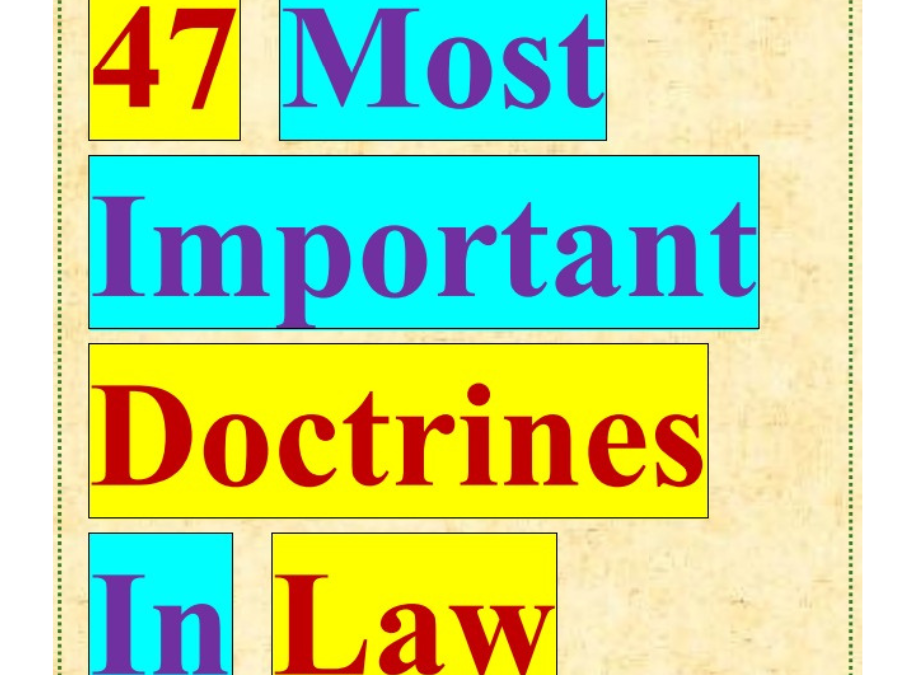
Looking for a Trusted Criminal Lawyer in Noida? Meet Advocate AK Tiwari
October 7, 2025
Divorce Lawyer in Surajpur Court
October 13, 2025Constitutional and Governmental Doctrines Doctrine of Judicial Review
Meaning: Grants courts the power to examine and nullify governmental actions that conflict with the constitution.
Applications: o Marbury v. Madison is the landmark case where this doctrine was established. o Used to invalidate laws and executive orders that overstep constitutional limits.
Interesting Insight: Judicial review is a cornerstone of checks and balances, evolving as courts reinterpret constitutional principles in light of new societal challenges.
Doctrine of Separation of Powers
Meaning: Divides government into three branches—legislative, executive, and judicial—to prevent the concentration of power.
Applications: o Each branch operates independently while checking the others. o Central to many modern constitutions to maintain a balanced government.
Interesting Insight: Rooted in Montesquieu’s writings, this doctrine continues to influence debates on executive power and legislative oversight.
Doctrine of Ultra Vires
Meaning: Actions taken by a body or official beyond their legal authority are null and void.
Applications: o Frequently applied in administrative law to challenge acts that exceed statutory limits.
Interesting Insight: This doctrine safeguards against governmental overreach, ensuring agencies and corporations act within the bounds of their legal authority.
Doctrine of Paramountcy
Meaning: Federal law prevails over conflicting state laws. • Applications:
Critical in resolving disputes in a federal system like the United States.
Interesting Insight: Paramountcy promotes national uniformity in legal standards, even as states retain significant legislative autonomy.
Doctrine of Originalism
Meaning: Interprets the Constitution based on its original meaning at the time it was adopted.
Applications: o Influences debates on constitutional amendments and judicial decisions.
Interesting Insight: Proponents argue it restrains judicial activism, while critics contend it may not adequately address modern realities.
Doctrine of Strict Construction
Meaning: Advocates for a narrow, literal interpretation of legal texts.
Applications: o Guides judges who emphasize fidelity to the text of statutes or constitutional provisions.
Interesting Insight: Often contrasted with more flexible interpretative methods, this doctrine underscores the tension between textualism and evolving social values.
Doctrine of Constitutional Avoidance
Meaning: Courts will interpret laws in a way that avoids constitutional questions unless absolutely necessary.
Applications: o Encourages resolving cases on nonconstitutional grounds, preserving judicial restraint.
Interesting Insight: Reflects a pragmatic approach to legal interpretation, balancing respect for legislative intent with constitutional limits.
Doctrine of Sovereign Immunity
Meaning: Protects governments from being sued without their consent.
Applications: o Limits lawsuits against public entities, though many governments have waived immunity in certain instances.
Interesting Insight: This doctrine illustrates the balance between protecting state functions and safeguarding individual rights in litigation.
Contract and Commercial Law Doctrines
Doctrine of Consideration
Meaning: A contract is enforceable only if each party provides something of value.
Applications: o Prevents gratuitous promises from being legally binding.
Interesting Insight: It is the lifeblood of contract formation, ensuring that agreements are the result of a genuine exchange of value.
Doctrine of Frustration of Purposec
Meaning: A contract may be discharged when an unforeseen event undermines its primary purpose.
Applications: o Often arises in situations involving drastic changes, such as regulatory shifts or natural disasters.
Interesting Insight: This doctrine highlights the dynamic nature of contractual obligations, recognizing that the context of an agreement can fundamentally change.
Doctrine of Contra Proferentem
Meaning: Ambiguities in a contract are interpreted against the party that drafted it.
Applications: o Commonly used in standard form contracts to protect the weaker party.
Interesting Insight: Acts as a fairness measure, ensuring that one party does not exploit ambiguous language to their advantage.
Doctrine of Pacta Sunt Servanda
Meaning: Agreements must be kept; contracts are binding.
Applications: o Provides the backbone for the enforceability of both domestic and international contracts.
Interesting Insight: This timeless principle reinforces trust in commercial relationships, essential for economic stability.
Doctrine of Good Faith
Meaning: Parties must act honestly and fairly during the performance of a contract.
Applications: o Frequently applied in employment, insurance, and commercial transactions to prevent opportunistic behavior.
• Interesting Insight:
The evolving interpretation of “good
faith” reflects society’s shifting expectations of fairness in business practices.
Doctrine of Equitable Estoppel
Meaning: Prevents a party from asserting a legal claim that contradicts their previous conduct or statements.
Applications: o Vital in contract disputes where reliance on a promise or representation has occurred.
Interesting Insight: This doctrine embodies the spirit of fairness, ensuring that parties cannot “back out” of their words when others have acted upon them.
Doctrine of Unconscionability
Meaning: Courts may refuse to enforce contracts or clauses that are extremely unfair.
Applications: o Protects consumers and weaker parties from exploitative contractual terms.
Interesting Insight: With the rise of complex financial products, unconscionability has become a crucial tool in modern consumer protection.
Doctrine of Non Est Factum
Meaning: A person is not bound by a document if they were fundamentally mistaken about its nature.
• Applications:
Acts as a defense in contract disputes when one party did not understand what they signed.
Interesting Insight: Although its application is rare, this doctrine underscores the importance of informed consent in contractual agreements.
Tort and Liability Doctrines. Doctrine of Last Clear Chance
Meaning: Even if a plaintiff is partly at fault, a defendant may be liable if they had the final opportunity to prevent the harm.
Applications: o Used in negligence cases to apportion responsibility.
Interesting Insight: Emphasizes that the opportunity to avert harm carries with it a corresponding duty of care.
Doctrine of Proximate Cause
Meaning: Establishes a direct causal link between the defendant’s actions and the plaintiff’s injury.
Applications: o Fundamental in determining liability in negligence cases.
Interesting Insight: The concept of foreseeability in proximate cause often spurs debates about the limits of liability in complex accidents.
Doctrine of Strict Liability
Meaning: Imposes liability on a party without needing to prove negligence or intent.
Applications: o Often applied in cases involving hazardous activities or defective products.
Interesting Insight: By shifting the burden of risk to the party engaging in dangerous activities, this doctrine underscores a policy of protecting public welfare.
Doctrine of Res Ipsa Loquitur
Meaning: The very nature of an accident implies negligence, even without direct evidence.
• Applications:
Allows courts to infer negligence in cases where an accident typically would not occur absent carelessness.
Interesting Insight: This doctrine is a powerful tool in litigation, transforming circumstantial evidence into a persuasive argument for negligence.
Criminal Law Doctrines Doctrine of Mens Rea
Meaning: Refers to the “guilty mind” or intent necessary to establish criminal liability.
Applications: o A key element in many crimes, ensuring that only those with culpable intent are punished.
Interesting Insight: Mens rea differentiates between accidental harm and criminal behavior, reflecting society’s nuanced view of moral culpability.
Doctrine of Actus Reus
Meaning: The physical act of committing a crime.
Applications: o Must be proven alongside mens rea to establish a complete case in criminal trials.
Interesting Insight: Together, actus reus and mens rea form the dual pillars of criminal responsibility, ensuring that both wrongful conduct and a culpable state of mind are present.
Procedural and Judicial Doctrines Doctrine of Precedent (Stare Decisis)
Meaning: Courts follow established judicial decisions to promote consistency.
Applications: o Central to common law systems, where past decisions guide future cases.
Interesting Insight: This doctrine is the backbone of legal predictability, ensuring that similar cases yield similar outcomes over time.
Doctrine of Res Judicata
Meaning: A final judgment on a matter prevents the same issues from being litigated again.
Applications: o Helps avoid repetitive litigation and conserves judicial resources.
Interesting Insight: The finality provided by res judicata is crucial for legal stability, even as societal values evolve.
Doctrine of Laches
Meaning: A claim may be barred if a party unreasonably delays in asserting their rights.
• Applications:
Acts as an equitable defense to prevent unfair surprise or prejudice.
Interesting Insight: Laches reminds litigants that justice requires timely action—a principle that deters stale claims.
Doctrine of Justiciability
Meaning: Only real, concrete disputes are appropriate for judicial resolution.
Applications: o Prevents courts from becoming embroiled in hypothetical or abstract disagreements.
Interesting Insight: This doctrine maintains the focus of the judicial system on actual controversies, ensuring that court resources are used efficiently.
Doctrine of Ratio Decidendi
Meaning: The essential legal reasoning behind a judicial decision.
Applications: o Forms the binding precedent that lower courts must follow.
Interesting Insight: Ratio decidendi crystallizes the principle behind a decision, influencing future interpretations and legal development.
Doctrine of Obiter Dicta
Meaning: Judicial comments not essential to the decision and not binding.
• Applications: Although non-binding, these comments can offer persuasive guidance in future cases.
Interesting Insight: Obiter dicta provide a window into a judge’s broader legal philosophy and may shape the evolution of legal thought.
Property Law Doctrines
Doctrine of In Rem Jurisdiction
Meaning: Jurisdiction over property itself rather than over the individuals owning it.
Applications: o Crucial in disputes involving real estate, foreclosures, and asset seizures.
Interesting Insight: This doctrine emphasizes that legal authority can be attached to an object, not just a person.
Doctrine of Adverse Possession
Meaning: Continuous, open, and hostile possession of property may lead to acquiring legal title.
Applications: o Resolves long-standing boundary disputes and clarifies property ownership after prolonged occupation
Interesting Insight: Commonly known as “squatter’s rights,” adverse possession challenges traditional notions of property by rewarding long-term, uncontested occupation.
Additional Doctrines Doctrine of Proportionality
Meaning: Legal responses and penalties must be proportionate to the harm or public interest involved.
Applications: o Guides criminal sentencing and administrative sanctions.
Interesting Insight: Proportionality ensures that governmental measures remain balanced, avoiding excessive or arbitrary punishment.
Doctrine of Lex Specialis
Meaning: Specific legal provisions override general ones when there is a conflict.
Applications: o Frequently used in statutory interpretation to resolve discrepancies between broad principles and detailed statutes.
Interesting Insight: This doctrine illustrates the layered complexity of law, where contextspecific rules can fine-tune general legal standards.
Doctrine of Lex Loci
Meaning: The law of the place where an event occurred governs its legal analysis
• Applications: Particularly important in international disputes and conflicts of law.
Interesting Insight: Lex loci ensures that local legal traditions and standards are respected in determining legal outcomes.
Doctrine of Public Trust
Meaning: Certain natural resources are held in trust by the government for the public’s benefit.
Applications: o Serves as the basis for environmental law and public resource management.
Interesting Insight: This doctrine embodies the idea that common resources like air, water, and parks belong to everyone and must be preserved for future generations.
Doctrine of Clean Hands
Meaning: A party seeking equitable relief must be free of wrongdoing in the matter at hand.
Applications: o Denies remedy when a plaintiff’s own unethical conduct contributed to the dispute Interesting Insight: “Clean hands” reinforces the ethical foundation of equity, ensuring that justice is available only to those who act fairly.
Doctrine of In Pari Delicto (18)
Meaning: When both parties are equally at fault, neither can obtain judicial relief.
Applications: o Common in cases where mutual misconduct has occurred.
Interesting Insight: This doctrine highlights the principle that courts are reluctant to intervene when both sides share blame.
Doctrine of Fair Dealing
Meaning: Certain uses of copyrighted or proprietary material are considered “fair” even without permission.
Applications: o Influential in intellectual property disputes and in interpreting contractual obligations.
Interesting Insight: Fair dealing is a balancing act, reconciling the rights of creators with the public’s interest in access to information.
Doctrine of Implied Warranty
Meaning: Even if not expressly stated, a seller warrants that goods are fit for their intended purpose.
Applications: o Essential in consumer protection, ensuring that buyers receive products that perform as expected.
Interesting Insight: Implied warranties foster trust in commercial transactions by providing a safety net against defective or unfit products.
Doctrine of Forum Non Conveniens
Meaning: A court may decline jurisdiction if another forum is significantly more appropriate.
Applications: o Used in international and multijurisdictional disputes to minimize inconvenience and cost
Interesting Insight: This doctrine recognizes that the best forum for justice may lie outside the courts where a case was originally filed.
Doctrine of Severability
Meaning: If one part of a contract or statute is invalid, the remainder may still be enforced.
Applications: o Preserves the integrity of legal documents by “severing” only the flawed provisions.
Interesting Insight: Severability underscores the principle that a single problematic clause should not undermine an entire agreement.
Doctrine of Legality
Meaning: Laws must be clear, foreseeable, and not applied retroactively.
Applications: o Ensures that individuals have fair notice of what conduct is prohibited.
Interesting Insight: This doctrine is a key safeguard against arbitrary enforcement and retrospective punishment.
Doctrine of Vicarious Liability
Meaning: One party (often an employer) can be held liable for the actions of another (such as an employee).
Applications: o Prominent in workplace and tort cases, it promotes accountability in hierarchical relationships
Interesting Insight: Vicarious liability reinforces the notion that control and supervision carry inherent responsibilities.
Doctrine of Harmonious Construction
Meaning: Statutory provisions should be interpreted so that all parts of the law work together coherently.
Applications: o Prevents conflicts between different statutes and ensures a unified legal system.
Interesting Insight: This doctrine reflects the judiciary’s role in synthesizing disparate legal texts into a harmonious whole.
Doctrine of Implied Consent
Meaning: Consent may be inferred from a party’s actions even if it is not expressly given.
• Applications:
Frequently applied in traffic law (e.g., consent to testing) and everyday transactions.
Interesting Insight: Implied consent recognizes that behavior can effectively serve as an agreement, streamlining legal processes.
Doctrine of the Reasonable Person Standard
Meaning: Determines liability by comparing a party’s actions to those of a hypothetical “reasonable person.”
Applications: o A benchmark in negligence cases to assess whether conduct met societal standards.
Interesting Insight: Though an abstract concept, the “reasonable person” is essential for ensuring objectivity in legal evaluations of behavior.
Doctrine of Respondeat Superior
Meaning: An extension of vicarious liability, holding employers responsible for their employees’ actions.
Meaning: An extension of vicarious liability, holding employers responsible for their employees’ actions.
Interesting Insight: This doctrine underscores that control over one’s agents entails a corresponding duty of oversight.
Doctrine of Mitigation of Damages
Meaning: Parties must take reasonable steps to minimize the losses resulting from a breach or wrongful act.
Applications: o Limits the recoverable damages in both contract and tort cases to losses that were reasonably avoidable.





